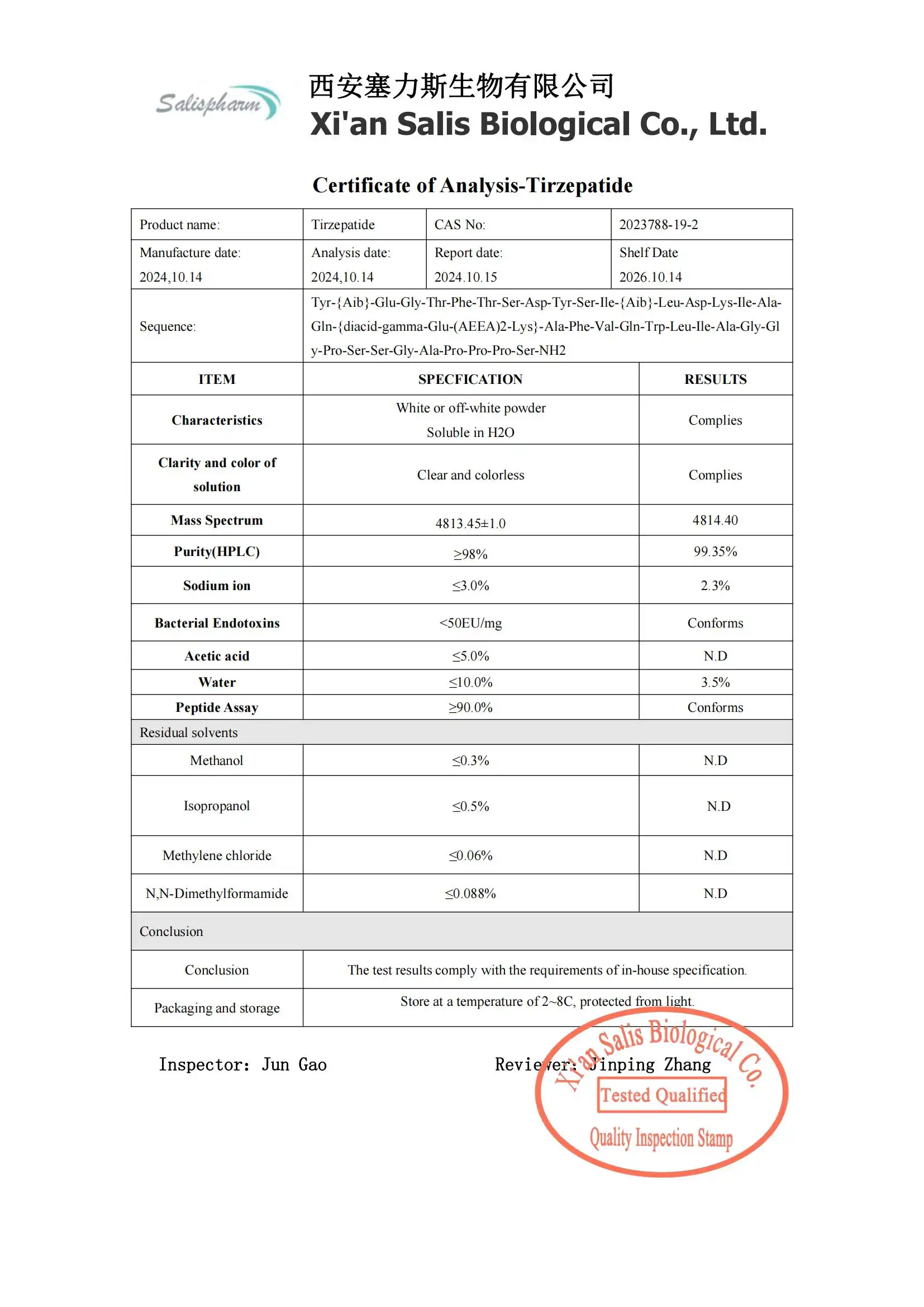Tirzepatide powder has emerged as a groundbreaking medication in the field of metabolic health, offering new hope for patients struggling with type 2 diabetes and obesity. This novel drug, developed by Eli Lilly and Company, is a dual glucose-dependent insulinotropic polypeptide (GIP) and glucagon-like peptide-1 (GLP-1) receptor agonist. Its unique mechanism of action has garnered significant attention from healthcare professionals and researchers alike, as it demonstrates remarkable efficacy in glycemic control and weight management. In this comprehensive guide, we will explore the clinical uses of tirzepatide powder, addressing some of the most frequently asked questions about this innovative treatment option.

How does Tirzepatide powder compare to other diabetes medications?
Tirzepatide powder represents a significant advancement in the treatment of type 2 diabetes, offering several advantages over existing medications. Its dual-action mechanism, targeting both GIP and GLP-1 receptors, sets it apart from single-receptor agonists like semaglutide or liraglutide.
One of the most striking differences is tirzepatide's superior efficacy in glycemic control. Clinical trials have consistently shown that tirzepatide leads to greater reductions in HbA1c levels compared to other diabetes medications. For instance, the SURPASS-2 trial demonstrated that tirzepatide was more effective than semaglutide in lowering HbA1c levels and promoting weight loss in adults with type 2 diabetes.
Moreover, tirzepatide's impact on weight loss is particularly noteworthy. While many diabetes medications are weight-neutral or may even lead to weight gain, tirzepatide has shown remarkable weight reduction properties. In clinical studies, patients treated with tirzepatide experienced significant weight loss, often surpassing the effects of other GLP-1 receptor agonists.
Another key advantage of tirzepatide is its potential to address multiple aspects of metabolic health simultaneously. By improving insulin sensitivity, reducing glucagon secretion, and slowing gastric emptying, tirzepatide not only helps control blood glucose levels but also positively impacts cardiovascular risk factors. This comprehensive approach to metabolic health is particularly beneficial for patients with type 2 diabetes, who often have concomitant conditions such as obesity and cardiovascular disease.
The dosing regimen of tirzepatide also offers some advantages. Administered as a once-weekly subcutaneous injection, it provides a convenient option for patients compared to medications requiring daily administration. This can potentially improve treatment adherence, a critical factor in the long-term management of chronic conditions like diabetes.
However, it's important to note that the choice of medication should always be individualized based on patient characteristics, preferences, and treatment goals. While tirzepatide shows promising results, it may not be suitable for all patients, and factors such as cost, insurance coverage, and potential side effects should be considered in the decision-making process.
What are the potential benefits of Tirzepatide powder for weight loss?
The potential of tirzepatide powder for weight loss has generated significant excitement in the medical community and among patients struggling with obesity. The drug's ability to promote substantial weight reduction, even in non-diabetic individuals, has led to its investigation as a potential treatment for obesity.
One of the most impressive aspects of tirzepatide's weight loss effects is the magnitude of weight reduction observed in clinical trials. In the SURMOUNT-1 trial, which focused on individuals with obesity or overweight (without diabetes), participants receiving the highest dose of tirzepatide (15 mg) achieved an average weight loss of 22.5% of their initial body weight over 72 weeks. This level of weight loss is unprecedented for a pharmacological intervention and approaches the results typically seen with bariatric surgery.
The mechanism behind tirzepatide's weight loss effects is multifaceted. By activating both GIP and GLP-1 receptors, tirzepatide influences several physiological processes that contribute to weight regulation:
- Appetite suppression: Tirzepatide acts on brain centers involved in appetite regulation, leading to reduced food intake and increased satiety.
- Slowed gastric emptying: The drug delays the rate at which food leaves the stomach, prolonging the feeling of fullness and reducing overall calorie intake.
- Improved insulin sensitivity: By enhancing the body's response to insulin, tirzepatide helps regulate blood glucose levels and may reduce fat storage.
- Increased energy expenditure: Some studies suggest that tirzepatide may increase resting energy expenditure, although this effect needs further investigation.
The weight loss achieved with tirzepatide is not only significant in terms of quantity but also quality. Clinical trials have shown that the majority of weight lost is fat mass, with preservation or even slight increases in lean body mass. This is particularly important as it helps maintain muscle strength and metabolic rate, factors that are crucial for long-term weight management.
Furthermore, the weight loss associated with tirzepatide appears to be durable. In extension studies, patients who continued treatment maintained their weight loss, suggesting that tirzepatide may be effective for long-term weight management when used as part of a comprehensive treatment plan.
The potential benefits of tirzepatide-induced weight loss extend beyond aesthetics. Significant weight reduction can lead to improvements in various obesity-related comorbidities, including:
- Cardiovascular health: Weight loss can lead to improvements in blood pressure, lipid profiles, and reduced risk of heart disease.
- Joint health: Reduced body weight alleviates stress on joints, potentially improving mobility and reducing pain in conditions like osteoarthritis.
- Sleep apnea: Weight loss often leads to improvements in sleep apnea symptoms and severity.
- Mental health: Achieving significant weight loss can boost self-esteem and reduce symptoms of depression and anxiety often associated with obesity.
While the weight loss effects of tirzepatide are impressive, it's crucial to emphasize that the drug should be used as part of a comprehensive weight management program that includes dietary modifications, increased physical activity, and behavioral changes. The long-term safety and efficacy of tirzepatide for weight management in non-diabetic individuals are still being evaluated in ongoing clinical trials.
Can Tirzepatide powder improve cardiovascular outcomes in diabetic patients?
The potential of tirzepatide powder to improve cardiovascular outcomes in patients with type 2 diabetes is an area of intense research and growing optimism. Cardiovascular disease remains the leading cause of morbidity and mortality in individuals with diabetes, making therapies that address both glycemic control and cardiovascular risk particularly valuable.
While long-term cardiovascular outcome trials for tirzepatide are still ongoing, early data and the drug's mechanism of action suggest promising cardiovascular benefits:
- Improved Glycemic Control: By effectively lowering blood glucose levels and HbA1c, tirzepatide helps reduce the chronic hyperglycemia that contributes to cardiovascular damage in diabetic patients. Improved glycemic control is associated with a reduced risk of microvascular complications, which can indirectly benefit cardiovascular health.
- Significant Weight Loss: The substantial weight reduction observed with tirzepatide use can have profound effects on cardiovascular risk factors. Weight loss is associated with improvements in blood pressure, lipid profiles, and insulin sensitivity, all of which contribute to better cardiovascular health.
- Blood Pressure Reduction: Clinical trials have consistently shown that tirzepatide treatment leads to significant reductions in both systolic and diastolic blood pressure. Hypertension is a major risk factor for cardiovascular disease, and its improvement can substantially reduce the risk of heart attacks, strokes, and heart failure.
- Lipid Profile Improvements: Tirzepatide has demonstrated beneficial effects on lipid profiles, including reductions in triglycerides and increases in high-density lipoprotein (HDL) cholesterol. These changes in lipid parameters are associated with a reduced risk of atherosclerosis and cardiovascular events.
- Inflammation Reduction: Chronic low-grade inflammation is a hallmark of both diabetes and cardiovascular disease. Some studies suggest that GLP-1 receptor agonists, including tirzepatide, may have anti-inflammatory effects, potentially contributing to cardiovascular protection.
- Direct Cardiovascular Effects: GLP-1 receptors are present in the heart and blood vessels. Activation of these receptors by tirzepatide may have direct cardioprotective effects, including improved endothelial function and reduced ischemia-reperfusion injury.
- Renal Protection: Tirzepatide has shown potential renoprotective effects, including reduced albuminuria and slowed progression of chronic kidney disease. Given the close relationship between renal and cardiovascular health, these benefits may translate to improved cardiovascular outcomes.
The SURPASS-CVOT trial, a large-scale cardiovascular outcomes trial for tirzepatide, is currently underway and will provide definitive data on the drug's impact on major adverse cardiovascular events (MACE) in patients with type 2 diabetes. This study will compare tirzepatide to dulaglutide, another GLP-1 receptor agonist with proven cardiovascular benefits.
While awaiting the results of long-term cardiovascular outcome trials, the multifaceted effects of tirzepatide on cardiovascular risk factors are encouraging. The drug's ability to simultaneously address multiple components of cardiometabolic health – including glycemic control, weight, blood pressure, and lipids – suggests a potential for comprehensive cardiovascular risk reduction in patients with type 2 diabetes.
It's important to note that while the potential cardiovascular benefits of tirzepatide are promising, the drug should be used as part of a comprehensive approach to cardiovascular risk management. This includes lifestyle modifications, such as a heart-healthy diet and regular physical activity, as well as appropriate use of other cardioprotective medications as indicated.
Conclusion
In conclusion, tirzepatide powder represents a significant advancement in the treatment of type 2 diabetes and obesity, with promising implications for cardiovascular health. Its unique dual-action mechanism offers superior glycemic control and weight loss compared to existing therapies, while also demonstrating potential benefits for cardiovascular risk factors. As ongoing research continues to elucidate the full spectrum of tirzepatide's effects, it may emerge as a valuable tool in the comprehensive management of metabolic health and cardiovascular risk in patients with type 2 diabetes. Healthcare providers and patients alike should stay informed about the evolving evidence surrounding this innovative medication to make informed decisions about its use in clinical practice. If you are also interested in this product and want to know more product details, or want to know about other related products, please feel free to contact lea_slsbio@163.com,WhatsApp+86 13193326505.

References
1. Frías JP, Davies MJ, Rosenstock J, et al. Tirzepatide versus Semaglutide Once Weekly in Patients with Type 2 Diabetes. N Engl J Med. 2021;385(6):503-515.
2. Jastreboff AM, Aronne LJ, Ahmad NN, et al. Tirzepatide Once Weekly for the Treatment of Obesity. N Engl J Med. 2022;387(3):205-216.
3. Rosenstock J, Wysham C, Frías JP, et al. Efficacy and safety of a novel dual GIP and GLP-1 receptor agonist tirzepatide in patients with type 2 diabetes (SURPASS-1): a double-blind, randomised, phase 3 trial. Lancet. 2021;398(10295):143-155.
4. Min T, Bain SC. The Role of Tirzepatide, Dual GIP and GLP-1 Receptor Agonist, in the Management of Type 2 Diabetes: The SURPASS Clinical Trials. Diabetes Ther. 2021;12(1):143-157.
5. Nauck MA, Quast DR, Wefers J, Meier JJ. GIP and GLP-1 in the pathophysiology of type 2 diabetes and obesity: Potential treatment targets? Diabetologia. 2021;64(4):715-729.
6. Coskun T, Sloop KW, Loghin C, et al. LY3298176, a novel dual GIP and GLP-1 receptor agonist for the treatment of type 2 diabetes mellitus: From discovery to clinical proof of concept. Mol Metab. 2018;18:3-14.

